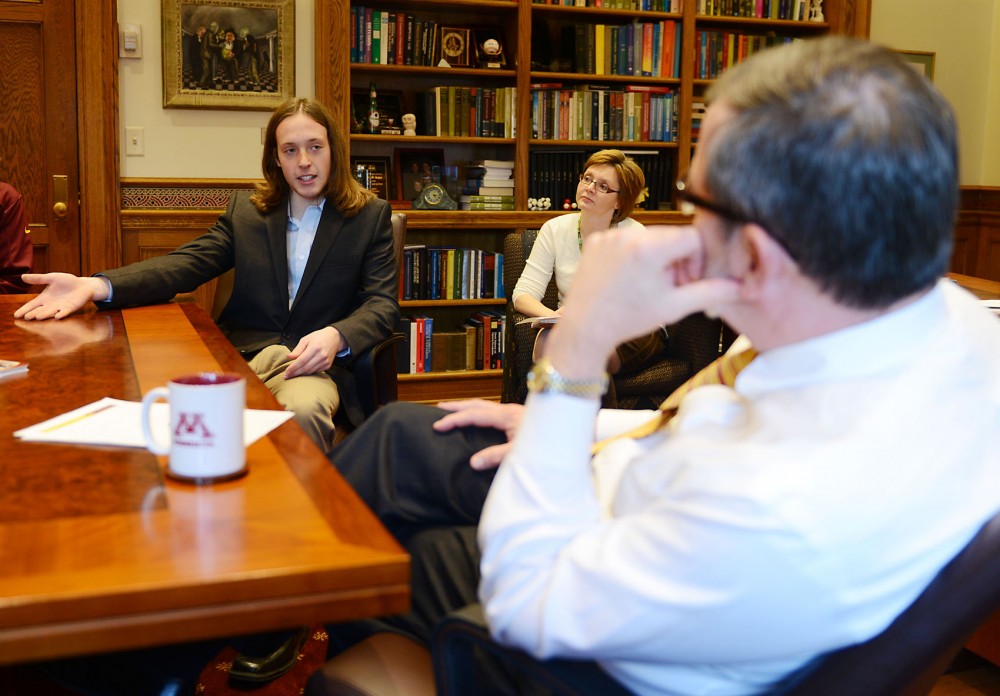University of Minnesota President Eric Kaler sat in his Morrill Hall office Friday afternoon as a dozen or so students bustled in and out, pitching their ideas to improve campus.
Kaler, who started hosting monthly office hours last spring, discussed bicycle traffic, safety procedures and other University issues last week.
Mechanical engineering senior Ben Pearce said he would like to see more bike lanes on the East Bank to alleviate accidents and increase accessibility.
Pearce said a permanent bike lane down the middle of the pedestrian-only section of Church Street would ease some of the congestion in that area.
Kaler agreed and said he would present the idea to the University’s Parking and Transportation Services.
“This is a missing link in organized biking,” Kaler said.
The Minnesota Public Interest Research Group unsuccessfully proposed a similar plan in 2010, but Kaler said because bike traffic has increased in recent years, there’s a better chance of PTS creating the lane.
University Services spokesman Tim Busse said a PTS study this fall found there were 1,000 new bikers compared to last year — more than a 13 percent increase.
Pearce also said bike safety is problematic near the Washington Avenue Bridge. Because the designated bike lanes outside the Science Teaching and Student Services building near the bridge are too close to the building’s doors, students don’t always see bikers coming, he said.
“The priority is pedestrians, and I get that, but at the same time, I think it’s important to encourage people to bike,” Pearce said.
Kaler agreed the spot is a major problem area and said the University is continuously looking to solve the campus’s transportation puzzle.
The University will likely wait to make any major transportation changes on campus until the Central Corridor light rail is up and running this spring, Busse said.
“This mess is 150 years in the making,” he said. “We’re not going to fix it overnight.”
On Friday, Vice President of University Services Pam Wheelock sent an email to students, asking for their help in improving transportation safety on campus.
The University is looking for recommendations for improving bike and pedestrian interactions, she said in the email.
Separating bicycle and pedestrian paths is the University’s long-term transportation goal, Kaler said.
Safety procedures
In response to last Monday’s armed robbery on West Bank, the University is working to streamline safety precautions, Kaler said at his office hours Friday.
Biomedical engineering freshman Donald Bystrom said he was in Anderson Hall last Monday when he received the University text alerting students about an armed man in the building.
Bystrom said his professor didn’t know what to do and relied on some students’ previous emergency training to keep the class safe.
“It was pretty scary for a good hour,” he said.
Kaler said he was surprised by Bystrom’s experience and thought University faculty and staff knew what to do in case of an emergency.
“I certainly assumed it, but you know that obviously wasn’t a good assumption in your case,” he told Bystrom, “and it’s probably not a good assumption overall.”
The University held an emergency training exercise in August to prepare for potential major incidents on campus, though the drill only involved the school’s emergency personnel and Minneapolis safety agencies.
Faculty and staff aren’t currently mandated to participate in emergency training, University spokeswoman Brooke Dillon said.
Dillon said the University’s department of emergency management is currently forming committees to create safety plans for every building system-wide.
The plans will include specific protocols for faculty in emergency situations.
“We’re [adapting] as quickly as we can,” Kaler said.


